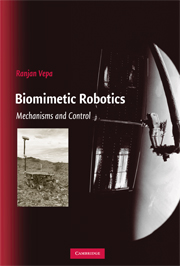Book contents
- Frontmatter
- Contents
- Preface
- Acronyms
- 1 The Robot
- 2 Biomimetic Mechanisms
- 3 Homogeneous Transformations and Screw Motions
- 4 Direct Kinematics of Serial Robot Manipulators
- 5 Manipulators with Multiple Postures and Compositions
- 6 Grasping: Mechanics and Constraints
- 7 Jacobians
- 8 Newtonian, Eulerian, and Lagrangian Dynamics
- 9 Path Planning, Obstacle Avoidance, and Navigation
- 10 Hamiltonian Systems and Feedback Linearization
- 11 Robot Control
- 12 Biomimetic Motive Propulsion
- Answers to Selected Exercises
- Appendix: Attitude and Quaternions
- Bibliography
- Index
4 - Direct Kinematics of Serial Robot Manipulators
Published online by Cambridge University Press: 20 February 2010
- Frontmatter
- Contents
- Preface
- Acronyms
- 1 The Robot
- 2 Biomimetic Mechanisms
- 3 Homogeneous Transformations and Screw Motions
- 4 Direct Kinematics of Serial Robot Manipulators
- 5 Manipulators with Multiple Postures and Compositions
- 6 Grasping: Mechanics and Constraints
- 7 Jacobians
- 8 Newtonian, Eulerian, and Lagrangian Dynamics
- 9 Path Planning, Obstacle Avoidance, and Navigation
- 10 Hamiltonian Systems and Feedback Linearization
- 11 Robot Control
- 12 Biomimetic Motive Propulsion
- Answers to Selected Exercises
- Appendix: Attitude and Quaternions
- Bibliography
- Index
Summary
Definition of Direct or Forward Kinematics
Kinematics is the study of the motion attributes of a collection of bodies without any reference to the forces or moments that may have caused it. In the context of robotics in general and robot manipulators in particular, it is the geometry of the mechanism that plays a pivotal role in the determination of the kinematics and the associated kinematic relations. Of primary importance are the relations expressing the position and orientation coordinates of the end-effector in terms of the DOFs at each joint. The objective is to establish parameters characterizing each link in a general coordinate system for satisfying the kinematic requirements of a manipulator. To find the location of the end-effector, only the DOFs at the joints, the joint variables, are given, and the problem is to express the position and orientation of the end-effector, the pose of the end-effector, in terms of the given variables. This is the direct or forward kinematics problem. For serial manipulators the direct kinematics is a unique relation, i.e., the location of the end-effector may be uniquely represented in terms of the joint variables.
Although the joint variables may be defined in an arbitrary fashion, a method of frame assignment proposed by Denavit and Hartenberg has emerged as a standard. The advantage of this systematic labeling of joint variables is that the associated homogeneous transformations may be decomposed into a product form that was discussed in the last chapter.
The Denavit–Hartenberg Convention
Robot manipulators are mechanisms involving a sequence of links connected together at the joints.
Information
- Type
- Chapter
- Information
- Biomimetic RoboticsMechanisms and Control, pp. 74 - 88Publisher: Cambridge University PressPrint publication year: 2009
